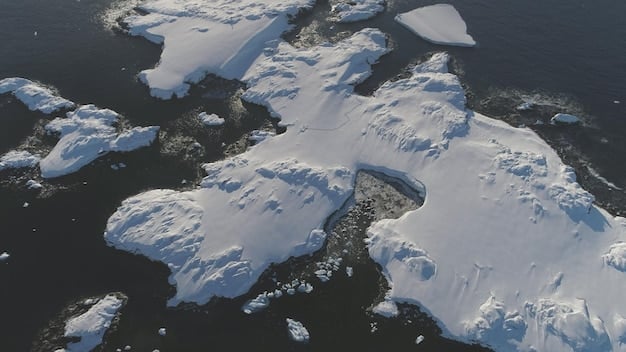US National Security in the Arctic: The 3 Biggest Threats

Navigating the increasingly complex geopolitical landscape, the United States faces three paramount threats to its national security interests in the Arctic: an intensified great power competition, the escalating impacts of climate change, and the growing challenges associated with critical infrastructure protection.
The Arctic, once a remote expanse, is rapidly becoming a focal point for global strategy. Its melting ice caps are opening new maritime routes and revealing vast reserves of natural resources, transforming it into an arena of intensified geopolitical maneuvering. Understanding what are the 3 biggest threats to US national security in the Arctic is crucial for effective policymaking and safeguarding American interests in this emerging frontier.
The Intensification of Great Power Competition
The strategic significance of the Arctic is undeniable, drawing the attention of major global powers. As ice recedes, new shipping lanes, like the Northern Sea Route, become more navigable, significantly reducing transit times between Asia and Europe. This geographic advantage, coupled with the region’s estimated 13% of the world’s undiscovered oil and 30% of its undiscovered natural gas, fuels a renewed great power competition.
Russia, with its extensive Arctic coastline and historical presence, views the region as a vital strategic backyard. It has demonstrably increased its military footprint, reactivating Soviet-era bases, upgrading its Northern Fleet, and deploying advanced missile systems. This buildup aims to secure its strategic interests, control key shipping routes, and project power.
Russia’s Assertive Presence
Russia’s military modernization in the Arctic is comprehensive, encompassing land, sea, and air capabilities. Its actions demonstrate a clear intent to dominate the Northern Sea Route and assert its territorial claims. This includes:
- Reactivation of military bases: Numerous Soviet-era military installations have been brought back online and modernized.
- Development of icebreaker fleet: Russia possesses the world’s largest fleet of nuclear-powered icebreakers, crucial for year-round access.
- Deployment of advanced weaponry: This includes sophisticated air defense systems and anti-ship missiles.
China, despite not being an Arctic nation, declared itself a “near-Arctic state” and is actively seeking to expand its influence through economic investments and scientific research. Its “Polar Silk Road” initiative connects Arctic shipping routes with its Belt and Road Initiative, signaling a long-term strategic commitment. China’s growing presence, particularly its interest in natural resources and potential dual-use infrastructure projects, adds another layer of complexity to the region’s security dynamics.
The United States and its allies face the challenge of countering these assertive strategies while upholding international law and freedom of navigation. The lack of a robust, persistent U.S. presence, particularly in terms of icebreaking capabilities and military infrastructure, creates potential vulnerabilities. Maintaining deterrence and ensuring strategic access become paramount as this competition intensifies, requiring significant investment and coordinated diplomatic efforts.
The Accelerating Impacts of Climate Change
While often viewed as an environmental concern, climate change represents a profound national security threat in the Arctic, ushering in a series of destabilizing effects. The rapid melting of sea ice and glaciers is not merely an ecological phenomenon; it is fundamentally reshaping the geopolitical and operational environment of the region, opening up new access points and exacerbating existing vulnerabilities.
The diminishing ice cover has two primary security implications. Firstly, it enhances the navigability of Arctic waterways, extending shipping seasons and potentially creating new permanent routes. This increased maritime traffic, while offering economic opportunities, also presents challenges related to search and rescue, environmental protection, and potential confrontations over access and jurisdiction. Secondly, the melting permafrost destabilizes existing infrastructure, from military installations and airfields to civilian settlements and energy pipelines, demanding significant adaptation and investment to maintain operational readiness and societal stability.
Operational and Environmental Challenges
The changing Arctic environment poses unique challenges for military operations and infrastructure. The unpredictable ice formations, extreme weather shifts, and reduced ice cover necessitate specialized equipment and training for personnel. Operating effectively in such an environment requires adapting to conditions far removed from traditional theaters of operation.
- Search and rescue capabilities: Increased maritime activity demands enhanced capacity for search and rescue operations in remote, harsh conditions.
- Infrastructure resilience: Coastal erosion and thawing permafrost threaten military bases, ports, and critical civilian infrastructure.
- Environmental spill risks: More shipping increases the likelihood of oil spills and other environmental disasters, requiring robust response mechanisms.
From a strategic perspective, climate change-induced changes open the door to new geopolitical flashpoints. As more areas become accessible, competition for resources and territorial claims could escalate. This necessitates a proactive U.S. strategy that combines scientific research, international cooperation, and robust defense planning to mitigate risks and capitalize on emerging opportunities while safeguarding the environment. The U.S. Navy and Coast Guard, for instance, face increasing demands to operate and project presence in areas previously inaccessible, raising questions about current capabilities and future investment priorities.

Furthermore, the impacts of climate change are not uniform across the Arctic, leading to varied challenges for indigenous communities. Displacement, food insecurity, and health concerns arising from environmental shifts can create humanitarian crises that further strain regional stability and demand international attention. Addressing these human security dimensions is integral to a comprehensive Arctic strategy, recognizing that a stable region is one where all inhabitants are secure.
Protecting Critical Infrastructure and Digital Vulnerabilities
The remote and harsh environment of the Arctic makes its infrastructure inherently vulnerable, a fragility exacerbated by increasing geopolitical tensions and the impacts of climate change. Critical infrastructure in the region, encompassing energy pipelines, communication networks, scientific research stations, and military facilities, is essential not only for local populations and economic activities but also for broader national security interests. Protecting these assets from a range of threats, both physical and cyber, poses a significant challenge for the United States and its allies.
The harsh Arctic climate itself is a constant adversary. Extreme cold, powerful storms, and thawing permafrost present formidable engineering and maintenance hurdles. These environmental stressors make infrastructure more susceptible to damage and disruption, creating pathways for adversaries to exploit. Beyond natural phenomena, deliberate attacks, whether physical sabotage or cyber incursions, represent a grave threat to the functionality and integrity of these vital systems.
Cyber and Physical Vulnerabilities
Cybersecurity is a growing concern, as Arctic infrastructure increasingly relies on digital systems for operations and monitoring. The interconnectedness of these systems, coupled with their often remote locations and sometimes outdated security protocols, makes them attractive targets for state and non-state actors aiming to disrupt operations, gather intelligence, or create instability.
- Remote and isolated systems: Many Arctic facilities are difficult to physically secure and may have less robust digital defenses.
- Reliance on satellite communications: These can be vulnerable to jamming or spoofing, interrupting vital communications.
- Dual-use infrastructure: Civilian infrastructure like ports and communication lines can be exploited for military purposes.
Physical vulnerabilities include the difficulty of rapid response to incidents in remote areas, the exposure of infrastructure to extreme weather, and the potential for kinetic attacks. For example, damage to undersea cables carrying vital data, or an attack on strategic radar installations, could have cascading effects on military operations and civilian services. Ensuring the resilience of these systems requires significant investment in advanced monitoring technologies, redundant systems, and robust physical security measures. Moreover, international cooperation is crucial, as many Arctic infrastructure projects transcend national borders and shared threats necessitate collaborative defense strategies.
Developing a comprehensive protection strategy necessitates a multi-faceted approach. This includes investing in hardened, climate-resilient infrastructure, deploying advanced cyber defenses, and fostering international partnerships to share intelligence and coordinate responses. The US must also consider the potential for “gray zone” tactics, where adversaries employ non-military or plausible-deniability actions to undermine critical infrastructure without triggering a direct military response. Protecting the Arctic’s infrastructure is not just about defending physical assets; it’s about safeguarding the operational backbone of U.S. and allied security in a region poised for profound transformation.
Navigating the Evolving Geopolitical Landscape
The Arctic’s rapidly changing environment is inextricably linked to shifts in global power dynamics, creating a complex interplay of opportunities and challenges for the United States. The opening of new maritime routes and access to untapped natural resources has intensified interest from both traditional Arctic nations and aspiring players. This evolving landscape demands a nuanced understanding of geopolitical maneuvers and a strategic approach that balances competition with cooperation, particularly as non-Arctic states increasingly assert their interests.
Russia’s aggressive modernization of its Arctic military infrastructure, including the reopening of airfields and radar stations, clearly signals its intent to secure its northern flank and control the Northern Sea Route. This assertive posture, combined with its substantial icebreaker fleet, positions Russia as a dominant force in the region. China’s “Polar Silk Road” initiative adds another layer of complexity, as Beijing seeks to integrate Arctic shipping lanes into its broader economic and strategic ambitions. While China often frames its Arctic activities in terms of scientific research and economic development, concerns persist regarding potential dual-use capabilities and long-term geopolitical objectives.
Strategic Implications for US Alliances
The heightened stakes in the Arctic underscore the importance of U.S. alliances and partnerships with other Arctic nations. Collaborating with countries like Canada, Denmark (via Greenland), Finland, Iceland, Norway, and Sweden is vital for intelligence sharing, coordinated military exercises, and advocating for international norms. The collective strength of these alliances can help counterbalance assertive actions by adversarial states and maintain a rules-based order in the region.
- Joint military exercises: Enhancing interoperability and readiness among allied forces in Arctic conditions.
- Intelligence sharing: Coordinating assessments of threats and strategic developments.
- Diplomatic cooperation: Presenting a united front in international forums and upholding international law.
However, navigating these relationships while managing the geopolitical competition is a delicate balancing act. Maintaining freedom of navigation, ensuring environmental stewardship, and respecting the rights of indigenous populations are paramount. The U.S. strategy must avoid militarizing the region unnecessarily, while simultaneously demonstrating a credible capacity to protect its interests and deter aggression. This requires sustained diplomatic engagement, strategic investments in capabilities, and a commitment to multilateralism as the primary means of ensuring long-term stability and security in an increasingly contested Arctic.
Developing a Comprehensive US Arctic Strategy
Addressing the multifaceted threats to US national security in the Arctic requires a comprehensive and adaptive strategy that integrates defense, diplomacy, and environmental stewardship. The challenges posed by great power competition, climate change, and infrastructure vulnerabilities are interconnected, demanding a holistic approach rather than isolated responses. A robust strategy must acknowledge the region’s evolving dynamics, anticipate future challenges, and leverage existing strengths while investing in new capabilities.
At the core of such a strategy is the imperative to enhance the United States’ operational presence and capabilities in the Arctic. This includes significant investment in icebreaking capacity, which remains a critical gap compared to other Arctic powers. Modernizing military bases, improving domain awareness, and conducting regular exercises with allies are also essential for projecting deterrence and ensuring rapid response capabilities. Furthermore, developing specialized equipment and training for personnel operating in the extreme Arctic environment will be crucial for maintaining operational effectiveness.
Key Pillars of a Strategic Response
A comprehensive Arctic strategy rests on several interconnected pillars. These pillars aim to bolster the U.S. position while fostering a stable and secure regional environment:
- Enhanced Arctic presence: Increasing military and civilian assets, including icebreakers, forward operating locations, and surveillance capabilities.
- Strengthened alliances and partnerships: Deepening cooperation with Arctic and near-Arctic allies on security, scientific research, and environmental protection.
- Investment in resilient infrastructure: Developing climate-resilient critical infrastructure that can withstand extreme conditions and cyber threats.
Beyond military and infrastructure considerations, the strategy must also prioritize diplomatic engagement and adherence to international law. Upholding freedom of navigation, promoting responsible resource development, and supporting scientific cooperation can mitigate tensions and foster a rules-based order. Engaging with indigenous communities, whose traditional knowledge and livelihoods are integral to the Arctic, is also vital for ensuring that policies are culturally sensitive and socially equitable. Ultimately, a successful U.S. Arctic strategy will be one that not only safeguards national security interests but also contributes to the sustainable development and peaceful management of this globally significant region, adapting to its rapid transformation with foresight and agility.
International Cooperation and Future Outlook
The future of Arctic security is inextricably linked to the degree and nature of international cooperation among regional stakeholders. While competition for resources and influence is undeniable, the shared challenges of climate change, search and rescue, and environmental protection necessitate collaborative efforts. For the United States, fostering a cooperative framework remains a critical objective, even amidst geopolitical rivalries, to ensure stability and sustainable development in the high north.
The Arctic Council, though its work has been impacted by recent geopolitical tensions, historically serves as a crucial forum for addressing common concerns among Arctic states and indigenous peoples. Reinvigorating this body and other multilateral platforms for dialogue on non-security issues can help build trust and create pathways for future collaboration. Science diplomacy, in particular, offers a promising avenue for cooperation, as shared climate data and research on environmental impacts benefit all nations with Arctic interests.
Pathways for Collaboration and Deterrence
Balancing deterrence with the pursuit of cooperative solutions is a delicate but necessary act for the U.S. in the Arctic. This dual approach aims to prevent conflict while addressing shared challenges:
- Renewed diplomatic engagement: Utilizing forums like the Arctic Council to discuss environmental, scientific, and indigenous issues.
- Multilateral exercises: Conducting joint military and civilian exercises to improve interoperability in search and rescue and disaster response.
- Information sharing: Collaborating on domain awareness and data exchange to enhance maritime safety and security.
The long-term outlook for Arctic security depends heavily on how major powers navigate the tension between competition and cooperation. For the United States, a forward-looking strategy involves not only strengthening its own capabilities but also actively shaping the international legal and normative framework for the region. This includes advocating for responsible resource extraction, promoting international standards for maritime navigation, and supporting scientific endeavors that enhance understanding of the Arctic’s rapidly changing environment. Investing in these collaborative efforts, alongside maintaining a credible defense posture, will be vital for ensuring the Arctic remains a region of peace and opportunity rather than a new theater of conflict.

The path forward requires consistent diplomatic engagement, robust defense planning, and a deep understanding of the region’s unique environmental and social complexities. By addressing these critical threats through a balanced approach of vigilance and collaboration, the United States can secure its national interests and contribute to a stable and prosperous Arctic future. This dual approach will be instrumental in ensuring the U.S. remains a key player, safeguarding its strategic interests while promoting multilateral solutions.
| Key Area | Brief Description |
|---|---|
| geopolitical Competition | Increased rivalry from Russia and China over resources and new shipping lanes. |
| environmental Impacts | Melting ice creates new operational challenges and environmental risks. |
| critical Infrastructure | Vulnerability of essential facilities to physical and cyber threats. |
| international Cooperation | Crucial for addressing shared challenges and maintaining regional stability. |
Frequently Asked Questions About Arctic Security
The Arctic’s strategic importance has surged due to melting ice, opening new shipping routes like the Northern Sea Route, which reduces transit times. This also uncovers vast untapped natural resources, including oil and gas, intensifying geopolitical competition and economic interest among global powers.
Climate change impacts US national security by enhancing the navigability of Arctic waterways, leading to increased maritime traffic and potential jurisdictional disputes. It also threatens existing infrastructure with thawing permafrost and extreme weather, complicating military operations and civilian stability.
Russia is aggressively modernizing its military infrastructure and icebreaker fleet to dominate the Northern Sea Route. China, as a “near-Arctic state,” is expanding influence through economic investments and the “Polar Silk Road,” raising concerns about dual-use capabilities and long-term strategic goals.
Arctic critical infrastructure is vulnerable to extreme climate conditions and thawing permafrost, making it susceptible to physical damage. Additionally, its reliance on digital systems for operations makes it a prime target for cyberattacks, posing significant risks to energy, communication, and military facilities.
The US strategy focuses on enhancing its operational presence, investing in icebreaking capacity, and modernizing military bases. It also emphasizes strengthening alliances with other Arctic nations, promoting international law, and engaging in scientific cooperation to ensure regional stability and security.
Conclusion
The Arctic’s transformation from a frozen periphery to a geopolitical hotbed presents the United States with a complex array of national security challenges. The intensified great power competition, the escalating impacts of climate change, and the inherent vulnerabilities of critical infrastructure represent the three most significant threats. Addressing these interconnected issues demands a comprehensive and adaptive U.S. strategy that balances robust defense capabilities with sustained diplomatic engagement and international cooperation. By strategically investing in presence, fostering strong alliances, and upholding international norms, the United States can navigate this evolving landscape, secure its interests, and contribute to a stable and sustainable future for the Arctic region. The interplay of environmental change and geopolitical ambition necessitates a vigilant yet collaborative approach to ensure peace and prosperity in this high-stakes frontier.





